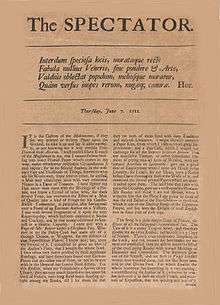The Spectator (1711)

The Spectator was a daily publication founded by Joseph Addison and Richard Steele in England, lasting from 1711 to 1712. Each "paper", or "number", was approximately 2,500 words long, and the original run consisted of 555 numbers, beginning on 1 March 1711.[1] These were collected into seven volumes. The paper was revived without the involvement of Steele in 1714, appearing thrice weekly for six months, and these papers when collected formed the eighth volume. Eustace Budgell, a cousin of Addison's, and the poet John Hughes also contributed to the publication.
Aims
In Number 10, Mr. Spectator states that The Spectator will aim "to enliven morality with wit, and to temper wit with morality". He hopes it will be said he has "brought philosophy out of closets and libraries, schools, and colleges, to dwell in clubs and assemblies, at tea-tables and coffee–houses". He recommends that readers of the paper consider it "as a part of the tea-equipage" and set aside time to read it each morning.[2] The Spectator sought to provide readers with topics for well-reasoned discussion, and to equip them to carry on conversations and engage in social interactions in a polite manner.[3] In keeping with the values of Enlightenment philosophies of their time, the authors of The Spectator promoted family, marriage, and courtesy.
Readership

Despite a modest daily circulation of approximately 3,000 copies, The Spectator was widely read; Joseph Addison estimated that each number was read by 60,000 Londoners, about a tenth of the capital's population at the time. Contemporary historians and literary scholars, meanwhile, do not consider this to be an unreasonable claim; most readers were not themselves subscribers but patrons of one of the subscribing coffeehouses. These readers came from many stations in society, but the paper catered principally to the interests of England's emerging middle class—merchants and traders large and small.
The Spectator also had many readers in the American colonies. In particular, James Madison read the paper avidly as a teenager. It is said to have had a big influence on his world view, lasting throughout his long life.[4]
Jürgen Habermas sees The Spectator as instrumental in the formation of the public sphere in 18th century England.[5] Although The Spectator declares itself to be politically neutral, it was widely recognised as promoting Whig values and interests.
The Spectator continued to be popular and widely read in the late 18th and 19th centuries. It was sold in eight-volume editions. Its prose style, and its marriage of morality and advice with entertainment, were considered exemplary. The decline in its popularity has been discussed by Brian McCrea and C. S. Lewis.
See also
- Bully Dawson – mentioned in The Spectator as being kicked by "Sir Roger de Coverley" in a public coffee house.
- The Spectator a current weekly British conservative magazine.
Notes
- ↑ Information Britain
- ↑ Addison, Joseph (1837). The Works of Joseph Addison, Vol. I, p.31. Harper & Brothers.
- ↑ Bowers, Terence. "Universalizing Sociability: The Spectator, Civic Enfranchisement, and the Rule(s) of the Public Sphere." In Newman, Donald J., ed. (2005). The Spectator: Emerging Discourses, pp. 155-56. University of Delaware Press.
- ↑ Ralph Ketcham, James Madison, A Biography, 1971, pp. 39-48
- ↑ Habermas, Jürgen (1989). The Structural Transformation of the Public Sphere: An Inquiry Into a Category of Bourgeois Society. Massachusetts Institute of Technology.
References
- The Spectator Nos. 1, 2, 10 [Addison], 1710–11.
- Brian McCrea, Addison and Steele are Dead: The English Department, Its Canon, and the Professionalization of Literary Criticism
- C. S. Lewis, "Addison" in Eighteenth Century English Literature: Modern Essays in Criticism ed. James Clifford.
Bibliography
Editions
The standard edition of The Spectator is Donald F. Bond's edition in five volumes, published in 1965.[1] Selections can be found in The Norton Anthology of English Literature.
- Ross, Angus (ed.) Selections from The Tatler and The Spectator (Harmondsworth: Penguin, 1982) [ISBN 0-14-043-130-6]. Edited with an introduction and notes. Out of print.
Further reading
- Henry W. Kent (1903). "Spectator". Bibliographical Notes on One Hundred Books Famous in English Literature. NY: Grolier Club.
External links
- The Spectator, Volumes 1, 2 and 3: With Translations and Index for the Series at Project Gutenberg (transcription of 1891 republication)
- Dear Mr Spectator, series 2 (BBC series by Elizabeth Kuti, adapted from and inspired by Joseph Addison and Richard Steele's 18th century Spectator essays)
- Hathi Trust
- The Spectator; Addison, Joseph, 1672–1719; Internet Archive
- ↑ Greenblatt, Stephen (ed.). The Norton Anthology of English Literature (8th ed.). p. A49. ISBN 0393925315.